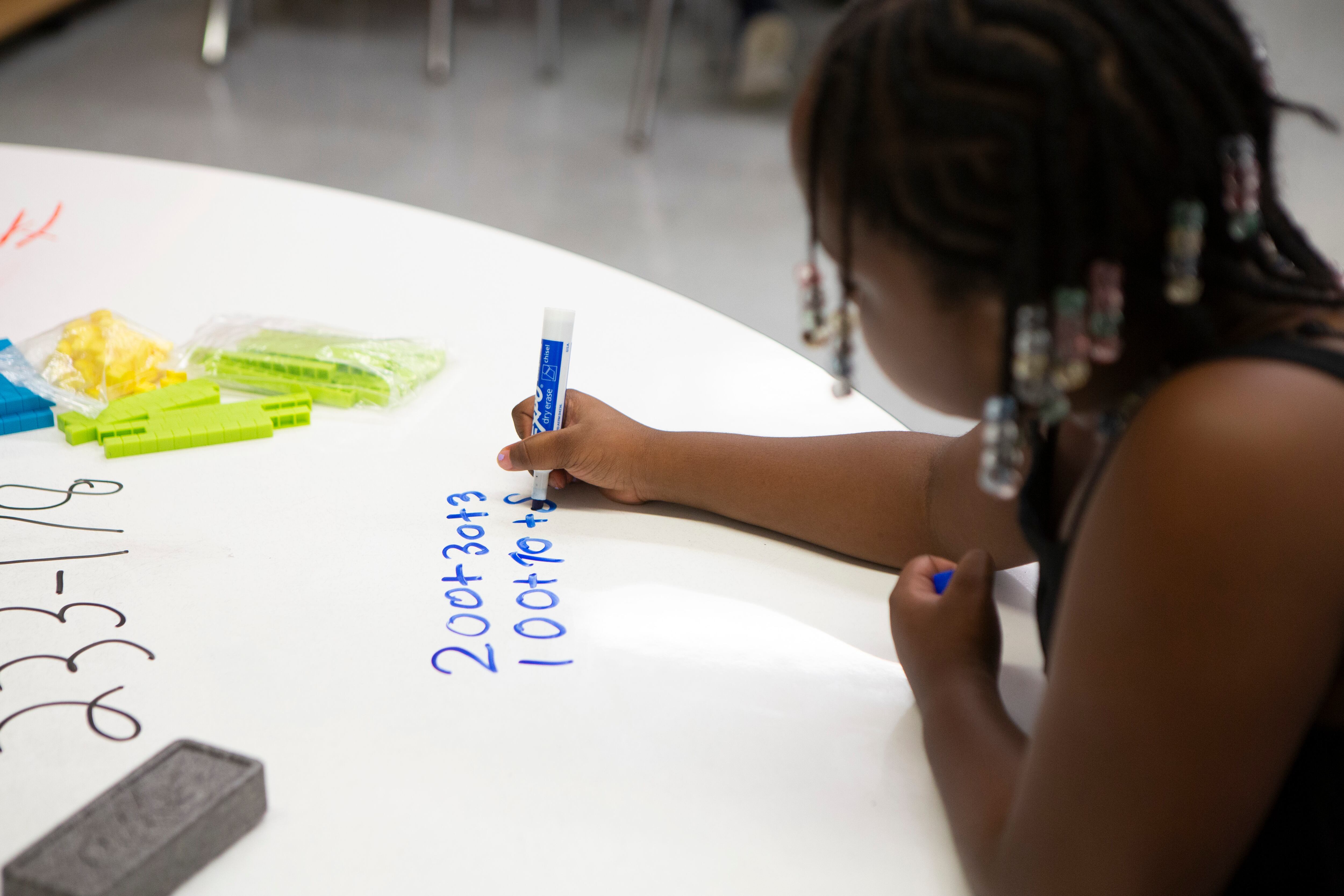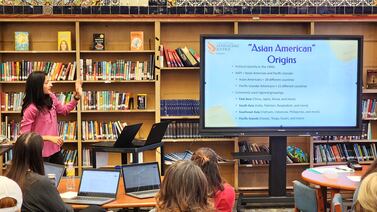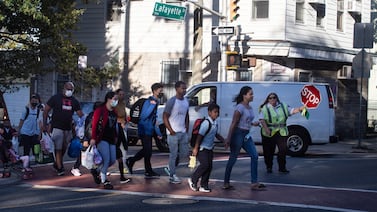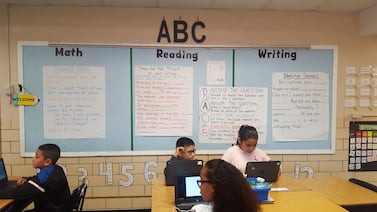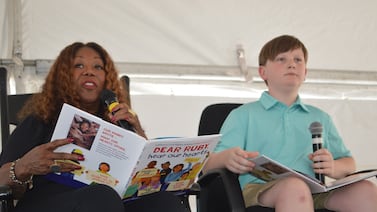Chicago Public Schools’ estimated 320,000 students will head back to class Monday for a school year that will be marked by old issues — and some new concerns.
The district’s enrollment has been dwindling for at least a decade, raising questions about how to best fund schools still recovering from the effects of the pandemic.
Funding overall has become more complicated as the city’s federal COVID relief dollars dry up. Much of that money has been used for supporting existing and additional staff, many of them providing extra academic support for students.
As the district decides on how, if at all, to continue funding some of those programs, it must also contend with the continued enrollment of incoming immigrant students.
Here are five issues Chalkbeat Chicago will be watching this school year:
A fiscal cliff is approaching
This is the last full school year before Chicago must earmark how to spend what’s left of nearly $3 billion it received in COVID relief aid from the federal government. The deadline is September 2024.
That means the district will soon be staring down a financial hole that has been filled by that influx of federal funds since the pandemic.
The district spent a large share of pandemic relief money on staff salaries and benefits. The district also spent hundreds of millions of dollars on academic recovery efforts, including after-school programs, an in-house tutor corps, and more counselors, social workers, and other support staff.
District officials have projected a budget shortfall of $628 million by the 2025-26 school year, raising questions about how Chicago will sustain any programs and services supported by the federal dollars.
A financial analysis released under former Mayor Lori Lightfoot noted that CPS “will not have a funding source” to keep up these academic recovery and social-emotional learning efforts.
As the district’s financial picture is becoming more precarious, Mayor Brandon Johnson has shared lofty plans for schools, including expanding the Community Schools model — leaving complicated financial decisions ahead.
The district’s state funding could also be in jeopardy if it fails to comply with a state law requiring that at least two staffers at each school are trained on the use of student restraint and timeout. The deadline for that, coincidentally, is the first day of school.
Student academic needs persist
Three years since the onset of the COVID pandemic, there are still signs Chicago students need extra help in the classroom. Students appear to be improving in reading achievement, but they’re gaining less ground in math, according to recent state test scores obtained by Chalkbeat.
As the district’s COVID dollars fade out, questions remain about how district officials will approach academic recovery, and whether there will be efforts to keep any of the extra support CPS has funded with the federal dollars.
Some of those COVID dollars went toward the creation of a $135 million universal curriculum called Skyline, which has received mixed reviews. The district has pressed schools not yet using the curriculum to prove they’re using another high-quality option, so it’s possible more campuses will use Skyline this year.
Additionally, Illinois’ General Assembly passed a new law requiring the State Board of Education to create a literacy plan for schools, which is due by the end of January 2024.
District grapples with continued dipping enrollment
Chicago’s public school enrollment has dipped by 9% since the pandemic began — a trend also seen among other big-city school districts — and is almost one-fifth smaller than it was a decade ago. Last year’s enrollment dip of 9,000 students was enough to push the district’s ranking from the country’s third largest public school system to the number 4 spot.
This year’s enrollment figures won’t be publicly released until later this fall.
As the district’s student body has thinned out, funding has grown — to $9.4 billion for the upcoming school year. Still, as the district has logged fewer students — including those from low-income families — CPS has in recent years received less state funding than it has projected. And with COVID aid running out, officials must grapple with how to fund schools serving a fraction of the kids they used to. (There is a citywide moratorium on school closures until 2025.)
Some advocacy and interest groups, including the teachers union, believe funding should be divorced from enrollment, in part because investing fewer dollars will only encourage more families to leave or to never enroll in public schools. Just over 40% of new budgets for schools this year was determined by student enrollment, with the rest accounting for other factors, such as student demographics.
Still, CPS CEO Pedro Martinez has emphasized that the district can’t factor out enrollment.
“In a large school district where schools serve 40 students, 400 students, and even 4,000 students, enrollment simply has to play a role in our funding formula,” Martinez previously told reporters.
Increase in migrant students poses new challenges
Last year, Texas officials began busing newly arrived migrants to Democratic-led cities, including Chicago. Since then, an estimated 12,000 migrants, many of whom are fleeing economic and political turmoil from South and Central American countries, have arrived in Chicago, While the district won’t say how many such students have enrolled, CPS saw roughly 5,400 new English learners last school year, Chalkbeat found.
Most Chicago schools have previously struggled with providing adequate language instruction for English learners. And with the city expecting more newcomers, educators and immigrant advocates recently told Chalkbeat that schools are not adequately resourced to serve these new students.
Some of these children may arrive without years of formal education and, if they’re learning English as a new language, are legally required to receive extra support.
The district’s number of bilingual teachers has dropped since 2015 even as the English learner population has grown, according to a Chalkbeat analysis. More teachers have earned bilingual education endorsements, which allows them to teach, but it’s unclear whether any of those educators are using those endorsements in the classroom.
District officials will be tasked with how to properly support these students. Officials had previously promised to release a formal plan by the first day of school but have not done so yet.
No district maps yet for the elected school board
As Chicago prepares to begin electing school board members next fall over the next two years, lawmakers have yet to approve maps that would designate which districts each board member would be elected from in the first round of elections. Ten members will be elected in November 2024, while the rest will be elected in November 2026, for a total of 21 members.
Illinois state lawmakers are in charge of approving those maps. In May, they extended their deadline to April 1, 2024, after concerns over whether the maps would match the makeup of the district’s student body or the city’s overall demographics.
Some observers cheered the extension. However, the delay presents new complications. If maps are not approved until April, the campaign season for the first set of districts would last just seven months, making it potentially challenging for candidates to prepare and for voters to have enough information ahead of Election Day.
Reema Amin is a reporter covering Chicago Public Schools. Contact Reema at ramin@chalkbeat.org.


